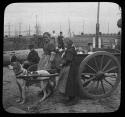Historical Background
The Keystone View Company was founded in 1892 by Benneville Lloyd Singley (d. 1938) in Meadville, PA. Singley was a former Underwood & Underwood salesman and an amateur photographer.
Singley began by selling stereocards that depicted the flooding of the nearby French Creek. His company grew to become the major distributor of stereographic images. By 1905, Keystone was the largest stereographic company in the world, specializing in national and international geographic and social science images. While the company’s images were popular forms of entertainment at first, television and film challenged that status during the early twentieth century, which caused Keystone to shift focus from entertainment to education. At that time, Underwood & Underwood had pioneered the field of educational stereoviews and lantern slide sales to schools, and the two companies competed for business. However, Keystone practiced a more aggressive sales method and more progressive editorial policies, which soon made them the acknowledged leader in the industry.
All of Keystone's manufacturing was done in Meadville, but branch offices were located in New York, St. Louis, San Francisco, Portland, Oregon, Chicago, Toronto, Canada and London, England. In 1963, Keystone’s education and stereoview departments were closed, and the company was bought by Mast Development Company. Keystone continued to manufacture eye training stereographic products as a subsidiary of Mast. In 1972, Mast closed the Meadville manufacturing site.
In 1978, Keystone’s records and inventory of negatives were given to the University of California Riverside.
Scope and Content
The 488 slides include images from the Americas, Europe, Asia, Africa, and Australia. They depict scenes from agricultural, industrial, commercial, urban, rural, transportation, nature, historical and daily life situation. Images date from the 1890s through the early twentieth century.
Related Materials (links to other collections)
The Historical Society of Pennsylvania (pdf)
National Museum of American History
Online Archive of California

